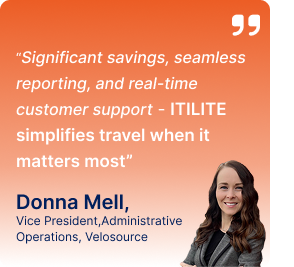
Hidden insights within a business travel report often refer to valuable information that may not be immediately apparent but can provide valuable insights into travel patterns, expenses, and the overall effectiveness of travel initiatives. This data can significantly impact decision-making and strategy development.
By delving deeper into the details of travel expenditures, patterns, and behaviors, organizations can reveal valuable insights into cost-saving opportunities, traveler preferences, policy compliance, and more.
Here are five hidden insights that you can tap into to make your business travel management program more efficient.
1. Traveler Behavior Analysis
Analyzing traveler behavior through travel reports involves extracting insights from data captured in various travel-related documents, such as itineraries, expense reports, booking records, and feedback surveys. After that, you can make strategic decisions and enhance travel management. Some insights available in a business travel report include:
Booking Patterns and Preferences
- Metrics Available: Analysis of booking patterns includes data on booking frequency, lead time, preferred booking channels (e.g., online platforms, travel agencies), and preferred travel times (e.g., weekdays vs. weekends, morning vs. evening flights).
- Leveraging Metrics: By understanding booking patterns, travel managers can negotiate better deals with vendors by consolidating bookings, securing discounts for early bookings, and optimizing travel schedules to align with preferred travel times. Additionally, identifying preferred booking channels helps streamline the booking process and ensure compliance with travel policies.
Travel Policy Compliance
- Metrics Available: Data on compliance with travel policies, including adherence to booking procedures, expense limits, and reimbursement guidelines, helps assess the effectiveness of travel policy enforcement.
- Leveraging Metrics: By monitoring travel policy compliance, organizations can identify areas where policies may need to be clarified or reinforced, provide targeted training or guidance to employees who consistently violate policies, and recognize and reward compliance. This helps ensure that travel management processes are efficient, transparent, and aligned with organizational goals.
Travel Destination Analysis
- Metrics Available: Data on frequently visited destinations, average duration of trips, and purpose of travel (e.g., meetings, conferences, client visits) provide insights into the travel preferences and business needs of employees.
- Leveraging Metrics: Travel destination analysis enables organizations to negotiate favorable rates with preferred hotels and transportation providers in high-traffic areas, identify opportunities for cost-saving measures (e.g., bulk purchasing of airfare), and tailor travel policies better to support the specific requirements of different types of trips.
2. Supplier Performance Evaluation
Supplier performance evaluation involves a comprehensive assessment of the performance of travel suppliers, such as airlines, hotels, car rental agencies, and travel management companies, based on various factors, including reliability, customer service, and value for money. Through a business travel report, you can gain insight into essential supplier metrics and leverage them in the following ways:
Reliability
- Metrics Available: On-time performance, room availability, and timely delivery.
- Leveraging Metrics: Identify consistent service delivery and minimize disruptions.
Customer Service
- Metrics Available: Responsiveness, issue resolution, satisfaction.
- Leveraging Metrics: Enhance traveler satisfaction and positive brand perception.
Value for Money
- Metrics Available: Cost-effectiveness, transparency, perceived value.
- Leveraging Metrics: Optimize budgets and justify expenses.
Contractual Compliance
- Metrics Available: Adherence to terms and pricing agreements.
- Leveraging Metrics: Mitigate legal risks and ensure service quality.
3. Expense Leakage Insights
Expense leakage analysis involves comprehensively examining expense reports to identify unauthorized expenses, policy violations, or inefficiencies in expense management processes. You can uncover the insights in a business trip report as follows:
Unauthorized Expenses
- Identification: Unauthorized expenses can include personal purchases, extravagant spending, or expenses incurred outside of approved travel guidelines.
- Analysis: By scrutinizing expense reports, organizations can detect unauthorized expenses through discrepancies in receipts, non-compliance with spending limits, or expenses categorized as personal rather than business-related.
- Impact: Unauthorized expenses can inflate travel budgets, compromise financial controls, and lead to budget overruns if left unchecked. Identifying and addressing unauthorized expenses is crucial for maintaining fiscal discipline and accountability.
Inefficiencies in Expense Management Processes
- Identification: Inefficiencies in expense management processes can manifest as delays in expense submission, errors in expense categorization, or duplication of expenses.
- Analysis: Analyzing expense reports allows organizations to identify bottlenecks, errors, or redundancies in the expense management workflow. This may involve tracking the time taken to process expense reports, identifying common errors in expense categorization, or identifying patterns of duplicate submissions.
- Impact: Inefficient expense management processes can lead to delays in reimbursement, increased administrative burden, and decreased employee satisfaction. By streamlining processes and implementing automation tools, organizations can improve efficiency, reduce processing times, and enhance overall expense management effectiveness.
Policy Violations
- Identification: Policy violations occur when employees fail to adhere to corporate travel policies regarding expense submission, approval procedures, or allowable expenses.
- Analysis: Conducting expense leakage analysis involves comparing expense reports against established travel policies to identify instances of non-compliance. This may include expenses exceeding predetermined limits, inappropriate use of corporate credit cards, or non-reimbursable expenses.
- Impact: Policy violations can undermine cost controls, erode trust in expense management processes, and expose the organization to regulatory compliance risks. By detecting and addressing policy violations, organizations ensure adherence to established guidelines and promote transparency and integrity in expense management.
4. Return on Investment (ROI) Analysis
Analyzing Return on Investment (ROI) through a business travel report involves examining various metrics and data points to assess the financial and strategic impact of travel expenditures. A business trip report can give you insight into:
Tangible Outcomes
- Revenue generated: Quantify revenue directly attributed to business travel activities, such as sales meetings or client visits.
- Deals closed: Track the number of deals closed during or shortly after business travel trips.
- Cost savings: Identify cost savings achieved through optimized travel arrangements, negotiated vendor contracts, or efficient expense management.
- Expense Efficiency: Calculate the return on investment for each trip by dividing the revenue generated or deals closed by the total expenses incurred.
Intangible Benefits
- Relationship building: Assess the frequency and quality of interactions with clients, partners, and colleagues during travel.
- Brand exposure: Measure the impact of representing the organization at conferences, trade shows, or industry events on brand visibility and recognition.
5. Environmental Impact Tracking
Environmental impact tracking involves monitoring and analyzing the ecological footprint generated by business travel activities, including carbon emissions, energy consumption, and waste generation. Through a business trip report, you can analyze the following insights
- Analyze carbon emissions data to identify the primary sources of emissions, assess the impact of travel activities on overall emissions, and track emission trends over time. This helps organizations understand their carbon footprint and prioritize emission reduction efforts.
- Analyze energy consumption data to identify areas of high energy usage, evaluate energy efficiency measures implemented by travel providers, and assess the overall environmental impact of travel activities. This helps identify opportunities for energy conservation and sustainable practices.
- Monitor compliance with eco-friendly travel policies through regular audits, traveler training programs, and incentives for sustainable behavior. This helps embed sustainability principles into corporate culture and ensures consistent adoption of environmentally responsible travel practices.
Leverage your Business Travel Report
Ever wished you could get all your travel reports right in your inbox without any hassle? Guess what? With ITILITE corporate travel management software, it’s possible! You can choose from a bunch of pre-built reports or even create your own custom ones from over 100 options tailored to your needs.
From breaking down expenses to analyzing traveler behavior, itilite has got you covered. No more digging through piles of data or struggling with complicated reports. Just sit back, relax, and let ITILITE do the heavy lifting for you.
Book a free trial with us to know more.













